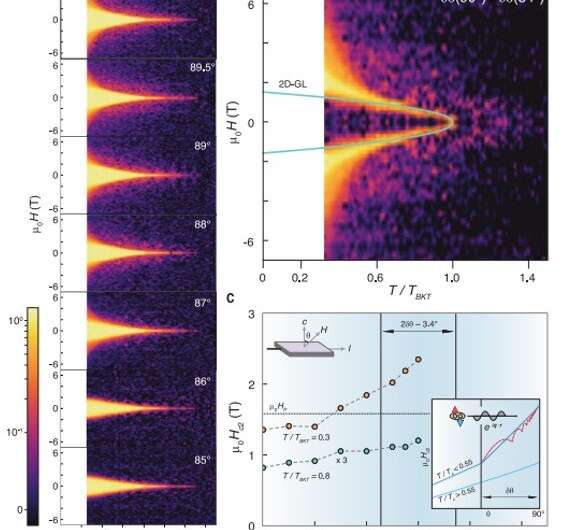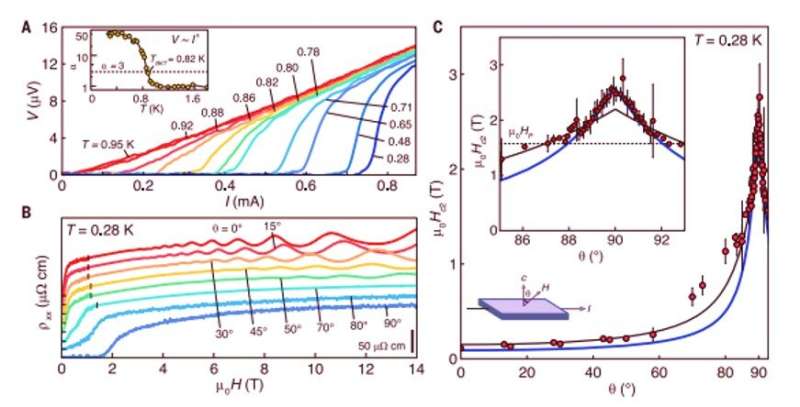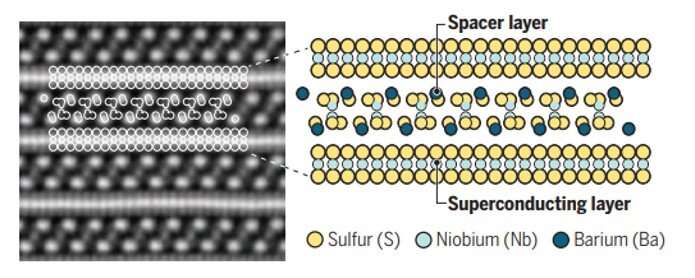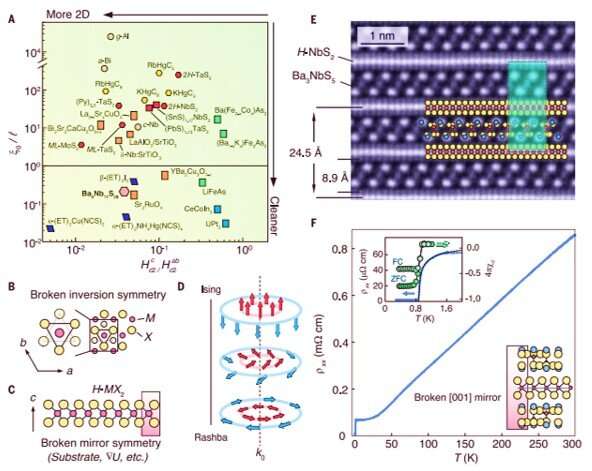October 16, 2020 feature
Layer-cake 2-D superconductivity: Developing clean 2-D superconductivity in a bulk van der Waals superlattice

Thamarasee Jeewandara
contributing writer

Materials science has had a profound on humanity since the advent of the . Presently, materials scientists are intrigued by a class of materials known as , whose electronic or magnetic behavior cannot be explained by classical physics. Discoveries in the field of quantum materials are followed by to uncover in science. In a new report now published on Science, A. Devarakonda and a team of scientists in physics at the Massachusetts Institute of Technology, Harvard University and the Riken Center for Emergent Matter Science in the U.S. and Japan reported the synthesis of a highly interesting novel quantum material.
The construct may allow physicists to study obscure quantum effects that have hitherto remained unknown. In this study, the team developed a bulk superlattice containing the (TMD) superconductor 2H-niobium disulfide (2H-NbS2, 2H phase) to generate enhanced two-dimensional (2-D), high-electronic quality and clean-limit inorganic superconductivity.
Superconductivity
Superconductivity can hypothetically allow high-speed applications without power loss and contribute to the development of concepts such as levitating express trains. Researchers can partly realize such applications at present using materials that superconduct at high enough temperatures and use 2-D materials to simplify problems, while highlighting the physics behind superconductivity. Early experimental works with granular aluminum (Al) and amorphous bismuth (Bi) films showed 2-D superconductivity by thickness, which were later used in ground-breaking studies. These include the (BKT) transition; an early example describing the topological transition, for which physicist received the in 2016.

In parallel, scientists have also studied to understand the superconducting state in the context of 2-D superconductivity, which include transition metal dichalcogenides (TMDs), i.e. atomically thin semiconductors of the type MX2 where M is a and X is a (group 16 elements in the periodic table). Recent advancements in materials engineering have also shown the possibility to exfoliate to allow atomically thin 2-D superconductors to be readily accessible. However, such flakes of exfoliation can degrade, reducing the sample quality. Devarakonda et al. therefore used high quality 2H-NbS2 (2H-niobium disulfide) monolayers in this work with a clean-limit 2-D superconductor exhibiting a BKT (Berezinskii-Kosterlitz-Thouless) transition. They then further synthesized a single-crystal material; Ba6Nb11S28 using high-quality H-NbS2 monolayers and Ba3NbS5 block layers, within which the TMD layers were strongly decoupled.
Developing and characterizing the layer-cake
Devarakonda et al. therefore made the resulting material (Ba6Nb11S28) as pure as possible to study the pure physics of 2-D superconductivity. The discovery of clean 2-D superconductivity in Ba6Nb11S28 will open the door to better understand 2-D superconductivity associated with quantum phenomena. The material contained alternating layers of the 2-D superconductor NbS2 and an electronically uninteresting spacer layer Ba3NbS5 – much like a layer cake with a thin layer of chocolate (i.e. NbS2) between thicker layers of cake (i.e. the spacer layer). The layering protected the NbS2 layer from cracking or air/moisture exposure to allow much cleaner 2-D superconductivity. The team used (HAADF-STEM) to investigate the resulting structure. The material displayed a clean-limit 2-D superconductor exhibiting a BKT transition at TBKT = 0.82 K and prominent 2-D (SdH) quantum oscillations; a macroscopic manifestation of the inherent quantum nature of matter.

Properties of the new quantum material
Using , Devarakonda et al. showed the cleanliness of the material and further evidence for the 2-D electronic architecture. The results were qualitatively different from the starting material 2H-NbS2, which maintained in its electronic structure. Although quantum oscillations had not yet been reported in 2H-NbS2, the team noted the onset of Shubnikov-de Haas (SdH) quantum oscillations in Ba6Nb11S28 within magnetic fields between 2 and 3 Tesla to indicate quantum mobilities. The scientists analyzed the quantum oscillations and low-field magnetoresistance of Ba6Nb11S28, which placed the materials in the clean limit of superconductivity.

They also recorded the current/voltage characteristics of the material across the superconducting transition. In addition to the observed BKT transition, the work showed the appearance of a clean, 2-D superconducting state with enhanced stability, which Devarakonda et al. credited to the high purity of the NbS2 layers in Ba6Nb11S28. Since the bulk Ba6Nb11S28 material already displayed 2-D physics, the research team originally proposed the now known process of inserting the spacer layers instead of fabricating exfoliated nanodevices detailed in previous work. The team also noted the scope to functionalize the spacer layer by introducing magnetic constituents. In this way, the large (average distance traveled by a moving particle) of Ba6Nb11S28 allowed clean-limit super-conductivity to potentially realize unconventional phases as predicted in .

Impact of the new quantum material
The inherent beauty of the material remains in the natural growth of the heterostructure, which much like a layer-cake naturally separated during the process of synthesis. This allowed the synthetic process to be much less labor-intensive compared to the manual addition of each layer. The ease of synthesis may allow different types of layered materials to be developed where the 2-D layers are naturally protected by their environment. The technique can yield different types of quantum materials aside from superconductors, including topological insulators . The new discovery allows a simpler, alternative approach to the existing process of exfoliated nanodevice fabrication. A. Devarakonda and colleagues envision extending this strategy to other materials beyond the Ba6Nb11S28 detailed here.
Written for you by our author —this article is the result of careful human work. We rely on readers like you to keep independent science journalism alive. If this reporting matters to you, please consider a (especially monthly). You'll get an ad-free account as a thank-you.
More information: Devarakonda A. Clean 2D superconductivity in a bulk van der Waals superlattice, Science, 10.1126/science.aaz6643
Schoop L. M. Layer-cake 2D superconductivity, Science, 10.1126/science.abd4225
Yu Saito et al. Superconductivity protected by spin–valley locking in ion-gated MoS2, Nature �鶹��Ժics (2015).
Journal information: Science , Nature �鶹��Ժics
© 2020 Science X Network





















